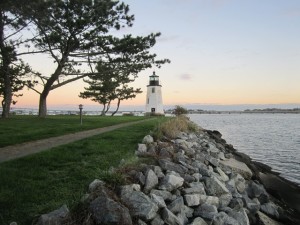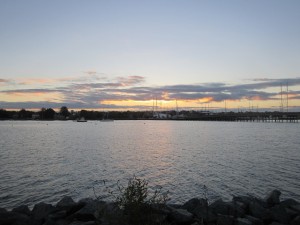 Late in the day on July 19, 1723, the bodies of 26 executed men were brought by boat from Newport, Rhode Island over to a narrow strip of land called Goat Island, barely 1,500 feet from the town’s shoreline. Hanged for being pirates, the men were all buried near the north end of the island, not far from where the Goat Island Lighthouse stands today. Their burial marked just one of a series of events that, over the years, have made little Goat Island a figure in many chapters of American history. Smallpox victims were also buried on the island in the 1700s. Colonists fired in anger at the British schooner St. John from the island in 1764, an event some claim marked the first shots of the American Revolution. Years later, many of the torpedoes used in World War I and World War II were developed and built in a plant on Goat Island.
Late in the day on July 19, 1723, the bodies of 26 executed men were brought by boat from Newport, Rhode Island over to a narrow strip of land called Goat Island, barely 1,500 feet from the town’s shoreline. Hanged for being pirates, the men were all buried near the north end of the island, not far from where the Goat Island Lighthouse stands today. Their burial marked just one of a series of events that, over the years, have made little Goat Island a figure in many chapters of American history. Smallpox victims were also buried on the island in the 1700s. Colonists fired in anger at the British schooner St. John from the island in 1764, an event some claim marked the first shots of the American Revolution. Years later, many of the torpedoes used in World War I and World War II were developed and built in a plant on Goat Island.
My fascination with Goat Island came through researching my new book about the dreaded pirate Edward Low and the young men he held captive for months on end, At the Point of a Cutlass. Goat Island figures prominently in Edward Low’s career as a pirate following the capture of one of Low’s two sloops by a British warship, the Greyhound, in June of 1723. Low himself escaped in another sloop, but all of the men aboard the captured sloop were brought back to Newport and put in jail (a few of the men escaped briefly when the jail-keeper brought them breakfast one morning, but the fugitives were soon captured again). At their trial, many of the young men pleaded their innocence, telling the court they were forced men and had sailed with the pirates only with “the greatest reluctancy and horror of mind and conscience.”
One of these men was Joseph Libbey, a 19-year old fisherman from Marblehead, Massachusetts, who had been captured a year earlier along with Philip Ashton, Libbey’s friend and crewmate. Ashton, as I recount in my book, was able to escape from the pirates by marooning himself on an uninhabited Caribbean island. But Joseph Libbey was still sailing with the pirates when the sloop was overpowered by the Greyhound and, with many others, he was forced to stand trial in Newport. Libbey showed the court a deposition from several ship captains attesting that he had been forced aboard the pirate ship, but that was not enough to counter the testimony of other witnesses. John Kencate, a doctor who had also been held aboard the pirate ship, told the court that Libbey was an “active man aboard the Ranger, and used to go on board vessels they took and plundered, and that he saw him fire several times.”In the third week of July in 1723, Libbey and twenty-five other condemned men were hanged on Gravelly Point in Newport in what remains one of the largest mass executions in American history. Their bodies were then taken over to Goat Island to be buried. Today, there is no evidence of the pirates’ burial on Goat Island, or of many of the other events that colored the island’s rich history. The island is fairly well-developed, with a hotel, other buildings and boatyards, and several long piers jutting at angles from the shore.
At the Point of a Cutlass was released in June 2014 and is on sale now.








